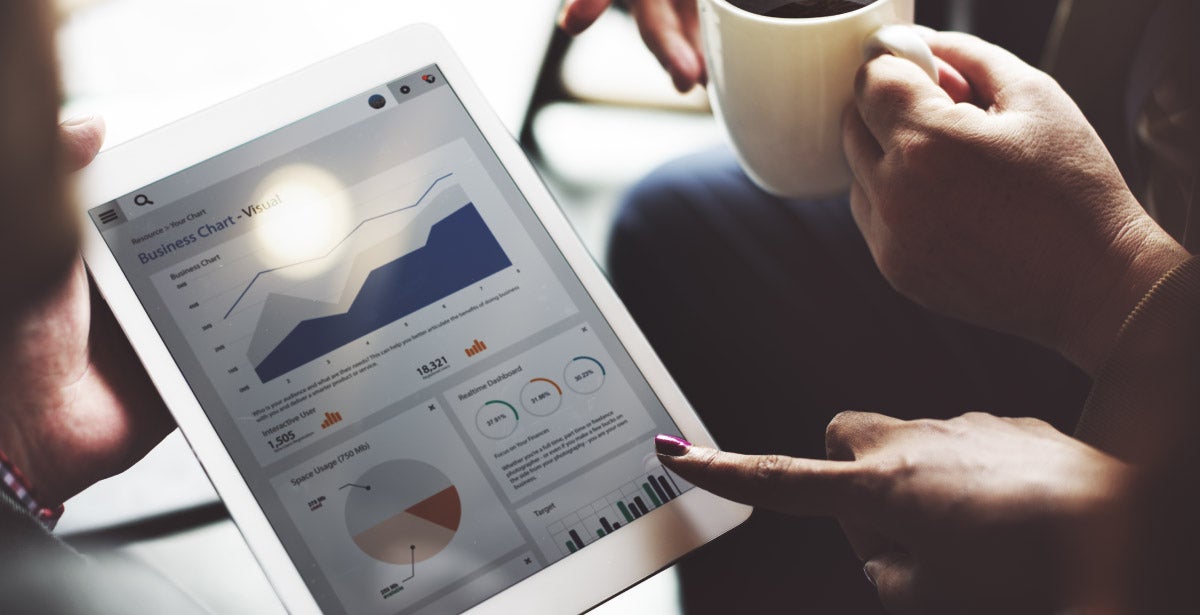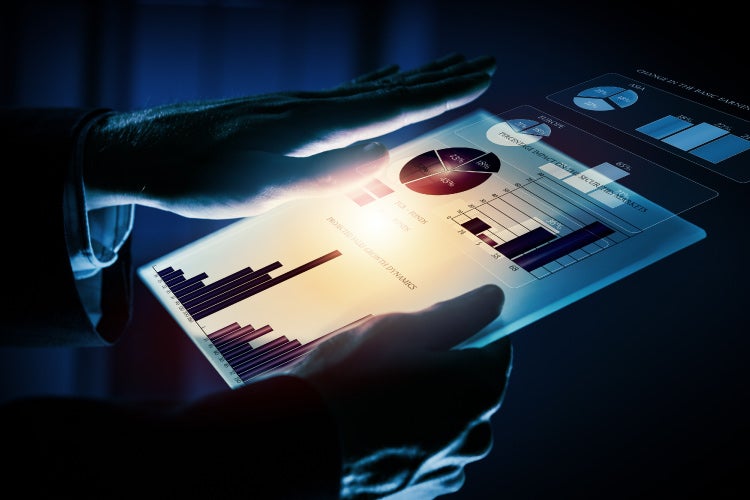Digital Marketing Analytics: Why They Are a Must-Have Marketing Skill

Analytical thinking and innovation, critical to every business function including marketing, is projected by LinkedIn to be the top skill in 2022. Before you can understand the importance of digital marketing analytics, you must first understand the context that transformed analytics from jumbled numbers to one of the most valuable commodities in today’s modern economy.
History of Data
The Information Age, also known as the Digital Age, started in the late 20th century and was marked by the stark shift from a reliance on industrial services to an economy ruled by information technology. Computing capabilities gave rise to the storage of this information online, creating the valuable commodity we know as data.
Companies with access to mass amounts of data have a strong foothold in their industries because they hold the key to insightful information about their products, customer behaviors and more. This explains in part why companies like Google, Facebook and Tesla are massively successful. The next question is: how can companies translate a high volume of information into meaningful insights?
Digital marketing analytics bridge the gap between the collection of data and the use of this data in a business setting. Digital marketers no longer rely on assumptions about the success of their campaigns; they create strategies informed by data. Smart marketers analyze data on a daily basis to fine-tune their campaigns in real time. Learn more about what digital marketing analytics is, which metrics are the most insightful, skills that help marketers excel, the importance of digital marketing analytics and the future of the industry.

What Is Digital Marketing Analytics?
Digital marketing analytics is defined as the translation of customer behavior into actionable business data. Digital marketers collect customer data, use digital marketing analytics tools to examine this data, and identify patterns that inform future marketing strategies. According to Social Media Today, “Analytics tell you what you’re doing right, and what you’re doing wrong. What’s working and what’s not working on all facets of your marketing, from social media to content to email marketing. If you’re not measuring you’re guessing.”
Important Digital Marketing Metrics
It’s up to digital marketers to determine which metrics or key performance indicators (KPIs) are valuable for their customers and industries. Some metrics can be misleading in the wrong context.
For example, the insights provided from organic traffic will be more appropriate for gauging the success of an SEO campaign than a social media campaign. In contrast, social traffic will be far more informative when analyzing the success of a social media campaign. Learn more about how metrics inform digital marketing analytics.
Digital Metrics for Websites
Web Analytics offers some of the most valuable data for digital marketing analytics, given that most channels direct a user to the website to take a desirable action. The digital metrics available on the website can inform user experience (UX) and map out exactly where visitors decide to either continue consuming website content or leave your site. Many digital marketing analytics experts use the following data to inform their website design, landing page copywriting and more.
Important Website Metrics
- Site load speed: The time it takes for your website page to load for a visitor. 1.3 seconds is the maximum page load time most industry insiders suggest.
- Visitor: The number of users visiting your site. Install a pop-up that requests users to accept cookies on their browser so they can be effectively tracked.
- Pageview: Every time a user loads one page on your website, this counts as a page view.
- Session: A session is characterized by how active the user is on your page. A user actively scrolling and clicking on the website is classified as a session. However, after 30 minutes of inactivity a session is terminated.
- Traffic: The total number of site or page visits made by a user. Marketers can also track the source of user traffics with the following metrics:
- Organic traffic: Users that have used a search engine to visit your website.
- Direct traffic: Users that have typed in a URL to land directly on your website.
- Paid traffic: Users that have entered your website through sponsored content or an ad.
- Referral traffic: Users that have entered your website through another website.
- Social traffic: Users that have clicked on a social media link or post to enter your website.
- Time spent on page: The amount of time a user has spent on your website.
- Interactions per visit: The number of actions a user has taken on your website.
- Bounce rate: The percentage of users who visited your website and did not take any actions or visit any other pages compared to the total number of site visitors.
Digital Metrics for Lead Generation
Lead generation is a top-of-the-funnel marketing stage where interested visitors become a part of a company’s list (email list, sales lead list, etc.). Once visitors enter their information in a lead generation form and opt to receive content from a business, they have successfully become a lead. For this reason, lead generation metrics are primarily about a visitor’s intentional actions.
Important Lead Generation Metrics
Click-through-rate (CTR): The percentage of total clicks on a call-to-action (CTA) compared to the total number of pages or site visits.
Form submissions: The total number of users who have entered their information into a form and clicked submit. This could be on a pop-up, an embedded form or a slide-in form.
Conversions: The number of users who have completed a desirable action on your website, such as make a purchase or download an eBook.
Pop-up clicks: The number of users who have clicked on a website pop-up.
Digital Metrics for Email Marketing
Email marketing continues to be an important component for digital marketers to connect with their leads. Digital marketing analytics use the following metrics to determine which subject lines are catching their lead’s attention, which email content prompts action, the success or failure of email CTAs and the quality of their email lists.
Important Email Metrics
- Open rate: The percentage of users who have opened your email, compared to the total number of emails delivered.
- Click-through rate (CTR): The percentage of users who have clicked a CTA in the email, compared to the total number of users who have opened the email.
- Bounce rate: The percentage of emails that were not delivered, compared to the total number of emails sent.
- Unsubscribe rate: The percentage of users who unsubscribed from the email list when compared to the total number of users on the email list.
Digital Metrics for Content Marketing
Content marketing professionals want to provide website visitors with relevant, high-quality content. How can digital marketing analytics determine whether a visitor found a relevant piece of content?
Metrics such as bounce rates can inform a marketer if a user landed on a relevant page. Time spent on page can also reflect whether or not a reader found the content valuable or interesting. The following metrics are especially insightful for content marketers.
Important Content Metrics
- Engagement rate: The total number of engagements on the piece of content, such as click, likes or comments, compared to the total number of content views.
- Time spent on page: The amount of time a visitor has spent on the piece of content. This often indicates an interest in the content.
- Bounce rate: The percentage of users who did not take any action on the content or continue to explore the site, compared to the total number of visitors to the piece of content.
- Form submission: The number of visitors who entered and submitted their information in a lead generation form on the content page.
- CTA click-through rate: The percentage of users who clicked on a CTA on the content page, compared to the total amount of visitors to the content page.
Digital Metrics for Social Media Marketing
Social media marketing is built on engagement, which is why the digital marketing analytics used for social are primarily concerned with the actions users are taking like commenting, sharing and liking. Although social media is becoming more concerned with providing referral website traffic, it continues to profit from keeping user’s attention.
Important Social Metrics
- Engagement rate: The total number of engagements on a social media post or page, such as clicks, likes or comments, compared to the total number of post views.
- Shares: The total number of visitors who have shared the social media post or page.
- Follows: The total number of followers on your social media account.

The Importance of Digital Marketing Analytics
Digital marketing analytics is more important now than ever before. This is because data is useless to marketers and advertisers if it has yet to be translated into meaningful, applicable insights. Digital marketers need to understand how to pull insights from customer behavior and find opportunities to increase revenue, improve UX and enhance customer satisfaction. Digital marketing analytics help marketers analyze data about customer behavior and better understand, improve and predict the customer journey.
1. Use Digital Marketing Analytics to Understand Customers' Preferences
Marketers use data and demographic to create customer profiles or customer personas. These profiles are designed to resemble the ideal customer that the product or service is targeting. What is the point of using digital marketing analytics to create these profiles?
A total of 50% of the marketers’ budget is wasted on unqualified traffic and leads. This means that using insightful data to target qualified traffic can reduce waste, locate the needs of your ideal customer and attract an audience that is more likely to convert.
2. Use Digital Marketing Analytics to Improve the Customer Experience
UX is the overall result of a customer journey, often on a website. Of course, companies aim to provide a smooth and high-quality UX so that users understand their message, easily navigate their site and hopefully convert as a result. Digital marketing analytics allows marketers to track the actions that a user takes on their site.
This means marketers can see where readers decided to exit from an article or abandon their cart online. Businesses can use these insights to remove obstacles and streamline UX to increase conversion rates.
3. Use Digital Marketing Analytics to Predict Customer Behavior
Digital marketing analytics not only provide insight into past customer experiences, but they also reveal patterns that can predict future behaviors. If a KPI has followed a particular trend, marketers can run an A/B test to measure change.
An A/B test is defined as “a method of comparing two versions of a web page or app against each other to determine which one performs better. AB testing is essentially an experiment where two or more variants of a page are shown to users at random and statistical analysis is used to determine which variation performs better for a given conversion goal.”
Marketers can also track trends and begin to anticipate the next big trend.
This allows businesses to stay ahead of the competition and create messaging that is always one step ahead.
For example, a holiday-specific recipe social media post could have produced high engagement. The team could use these digital marketing analytics insights to prepare a similar multi-channel recipe to attract even higher engagement for the following holiday.

The Future of Digital Marketing Analytics
What is the future for digital marketing analytics and how will it continue to shape the way businesses interact with their customers online? The first consideration is the evolution of data and analytics. Data science and machine learning are forcing marketers and advertisers to remain agile. New technologies are emerging such as AI-assisted algorithms and blockchain-enabled data storage. How do these innovations affect digital marketing analytics?
1. Digital Marketing Analytics and Artificial Intelligence
When sci-fi movies of the past envisioned robots taking over, they probably didn’t picture AI algorithms taking over tech jobs in Silicon Valley. AI’s primary presence in digital marketing analytics is its ability to quickly interpret and act on large sets of data.
This means that AI algorithms are able to turn mass amounts of unorganized data and create actionable insights. The capabilities of these AI formulas are in their infancy and are expected to evolve significantly over the next few years. In the future, digital marketing analytics will rely heavily on AI due to its accuracy, speed, and increasingly advanced ability to track, predict and alter customer behavior online.
2. Digital Marketing Analytics and Personal Digital Assistants
Hey Alexa, what’s the future of digital marketing analytics and personal digital assistants? Alexa, Google Home, and other personal digital assistants are mini AI robots that live in your house to learn your preferences, help you search inquiries and even order items of your choice.
Although personal digital assistants are ever-present, they’re expected to become increasingly popular; the market size was valued at USD 2,166.0 million in 2019 and is expected to grow at a compound annual growth rate of over 33% throughout 2020-2025. These PDAs collect data throughout the day and will be essential for data analysis of consumer behavior. Digital marketing analytics experts will see PDAs as valuable sources of information in creating customer profiles.
3. Digital Marketing Analytics and Chatbots
Chatbots are powered by AI and enable better customer service on a website. Website visitors can ask questions, resolve issues and be redirected without having to contact a real-life customer service representative. How is this relevant to digital marketing analytics? Digital marketers can begin to collect and analyze chatbot data to determine the frequently asked questions visitors have on their site or common pain points. Chatbot data can help marketers enhance on-site UX.
4. Digital Marketing Analytics and Voice Search
Personal digital assistants, mentioned in point two, raise yet another novel technology for digital marketers’ consideration: voice search capability. At present, the primary form of search engine optimization (SEO) revolves around what users are typing into the search bar online.
Voice search is a new avenue that will be increasingly present in digital marketing analytics. Not only do people voice search through PDAs, but they also ask their smartphone queries. The way people type and talk differs, meaning popular search queries could change. Digital marketers will need to analyze verbal long-tail keywords and tailor their content to match this new formula.
5. Digital Marketing Analytics and Influencer Marketing
Influencer marketing is expected to change drastically in the future. According to Social Media Today, “Today’s largest group of consumers - Millennials and Gen Z - prioritize authenticity above all else when choosing which brands they support and their trust in traditional influencers is at an all-time low.”
This means that organic influencer marketing will continue to take off. Organic influencer marketing is when influencers promote a brand without being paid or swayed to post a promotion simply because they use and enjoy the product or service.
Marketing and advertising agencies will be using real people and less celebrities or athletes to promote their products and services. Digital marketing analytics will continue to track this trend and capitalize on the trend by creating content that prioritizes authenticity.
6. Digital Marketing Analytics and Virtual Reality
Virtual reality has primarily been used for entertainment, with the introduction of VR goggles, but in the future, it could be used for much more. In fact, VR is expected to reach 98.4 million sales by 2023 with a population penetration of 2% worldwide, according to Forbes. Innovative marketing strategies could use VR to engage in immersive brand storytelling.
Marketers could even showcase their products in an immersive VR experience and track real-time biological reactions from their customers. This means digital marketing analytics could take behavioral analysis offline. Brands are already offering similar experiences. VR is already being used in a healthcare setting to help patients with anxiety disorders and phobias face their fears in an augmented reality.
VR is also being used to help enhance the education experience by creating virtual classrooms and even virtual tours through museums and art galleries. VR experiences will become ever-present in the future of digital marketing analytics.
Transform your Career Prospects with an MBA in Marketing
An MBA in Marketing can help set you apart from the competition, providing you with the skills and experience needed to lead and innovate in various business environments.
St. Bonaventure University offers an accredited online MBA with a marketing concentration that will help you develop effective marketing plans to drive business success.
- Make Strategic Decisions: Conduct market research and apply it to guide strategic decision-making about your organization.
- Develop Sound Strategy: Explore the nature of the consumer decision-making process and understand the implications for marketing strategy.
- Flexible: 100% online coursework. Study anywhere at any time
- Easy enrollment: No application fee. Apply with a BA or BS in any field. No GRE or GMAT is required.
- Competitive tuition
- Graduate in just under two years
St. Bonaventure University’s dedicated staff are ready to answer your questions and help you prepare for what’s next in your career. Learn more about the program and connect with an Enrollment Advisor to discuss your future career.
Prepare for a digital marketing career leveraging data with an online MBA in Marketing from SBU.
